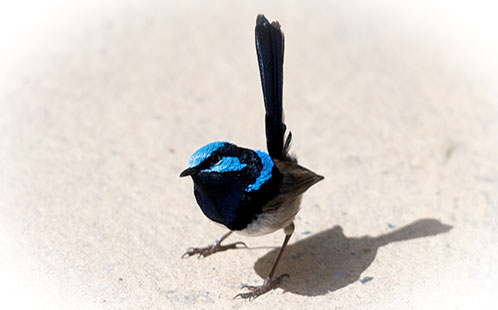
Dr Justin Welbergen
Research published in by scientists at Western Sydney University provides the first clear evidence that a species of perching bird (the passerines) can employ torpor – an energy-saving mechanism whereby the body temperature of an animal is temporarily reduced in a controlled way during resting.
In this new research, the authors used miniature radio-transmitters record the skin temperature of these tiny eight-gram birds over several weeks during winter in woodland near Sydney. Skin temperature provided a close approximation of body temperature in such small animals. Remarkably, they showed these fairy-wrens allow their body temperature to decrease substantially during their nightly roosting phase. These periods of nocturnal torpor closely resemble the torpor that is well-known in some small mammals and in a few non-passerine bird groups like hummingbirds. This new evidence of regular use of torpor by a passerine bird is important for understanding the physiology and ecology of birds.
Birds are typically small and light, which helps them to fly and escape from predators but means they cannot carry a lot of fat and this presents a challenge during winter when food is hard to find. The use of torpor provides a very effective mechanism to reduce the amount of energy required for thermoregulation when resting during the night. Torpor could be an important strategy allowing small birds to cope with limited and fluctuating food supplies.
“Even in a relatively mild climate, Superb Fairy-wrens benefit from the energy-savings that nocturnal torpor provides”, said Dr Christopher Turbill from the Hawkesbury Institute for the Environment at Western Sydney University.
“When roosting during the night, the bird can reduce its demand for energy by turning down its internal thermostat – reducing its core body temperature by nearly 15 degrees Celsius compared to during the daytime. We estimate this use of torpor saves the bird around 22% of the energy it would otherwise need. This helps to avoid starvation when food is hard to find, and means it doesn’t have to carry more weight as stored fat or risk being eaten by searching even harder for food when active”, said Chris.
This study is the first to record torpor in a representative of the perching birds or passerines, an order that contains around half of all bird species. Previously, torpor was well-known among several non-passerine groups, most notable the hummingbirds and nightjars, whereas passerine birds were only known to use mild torpor when they faced starvation.

Dr Justin Welbergen
“This finding provides clear evidence that torpor is used on a daily basis by a small passerine bird, even in Australia’s mild climate. Very few studies have measured the body temperature of wild passerine birds and our data suggest torpor might be more common than we thought,” said Alex Romano, who recently graduated from his .
“The Superb Fairy-wren has been used for decades as a model species to answer many important questions in behavioural ecology, so it is incredible that Alex managed to discover something so basic yet profound about the species’ fundamental biology”, said Dr Justin Welbergen who was also part of the research team.
By significantly reducing their daily energy needs, scientists propose that small mammals and birds use torpor to enhance their chances of surviving through winter, and because energy-savings from torpor reduce the need for foraging, its use can also reduce the likelihood of being consumed by predators during the active period of the day.






